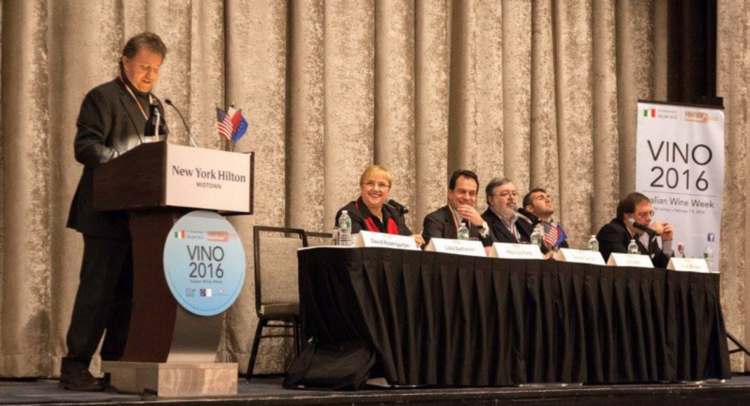


“Welcome to this minestrone of ideas. A minestrone titled Current Food, Wine & Restaurant Trends in Italy: Will they Happen Here?” With this question, TV personality, chef and author David Rosengarten introduced one of the most awaited for panels featured at VINO 2016-Italian Wine Week [2]. “This session looks at some of the key established and emerging trends in Italy with respect to wine, cooking and dining out.”
The panel featured some of today's greatest foodies and winos: Lydia Bastianich, TV host, chefand restaurateur, Daniele Cernilli, Italian wine critic, Dino Borri, International Head Buyer at Eataly, Ian D'Agata, Scientific Director at Vinitaly International Academy, and Trade Commissioner Maurizio Forte.
Yes, it all started with a question and audiences got a lot of very interesting information. First contributor was Lidia Bastianich, someone we could listen to for hours and hours. “In Italy people mostly eat at home,” she explained, “First because good eating means eating their mother's cooking, nobody makes it better, and secondly because of the economic crisis that is currently afflicting the country. On top of that lifestyle has changed, people are always on the run and there is less time to be spent in the kitchen preparing a family's recipe.
According to research conducted by Nielsen in 2015, Italians who eat at home mostly enjoy frozen foods, packaged goods, like cold cuts or pre-washed mixed salads, less meat (when eaten, white is preferred to red), more vegetables, especially if organic. Sounds pretty familiar, doesn't it? The average way of eating in the US is not that different at all. So what do restaurateurs do to stay afloat and attract customers? Smaller restaurants and trattorias are doing fine but chefs working at fine dining and Michelin starred restaurants fees the pressure to come up with new inventions for people to try and that respect Italy's culinary traditions.”
“Italy is a small country but there are thousands of differences: food and wine are affected by regionalism,” Cernili explained. “Each region has its ingredients and those are used to make specific, unique culinary specialties. For a Milanese, Neapolitan cooking is somewhat ethnic, not only because of the ingredients used but also because of the way such ingredients are combined. Generally speaking, Italians do not like creative, or so-called innovative cuisine, it's too intellectual... they are faithful to the ingredients and the culinary traditions their native region.”
“Each ingredient has a story,” Dino Borri added, “and in the US people are really interested in Italian ingredients. Even when you go to a restaurant that is not necessarily labelled Italian, there is something Italian on the menu: either a pasta dish or a bottle of red. At the moment people in the US are discovering Colatura d'Alici (anchovy sauce from the small fishing village of Cetara, Campania) and 'nduja (spicy, spreadable pork salami from Calabria) among other specialties. Yet in Italy, some people who are not from that region might not even be familiar with that specific product. But it is indeed trendy to discover new products, especially of the highest quality.”
“Trends change because society changes,” D'Agata had to add, “and now more then ever Italians are very aware of quality and of the health factor. We mentioned frozen foods, yes they are more popular, but most frozen food that is consumed are vegetables. People don't have time to peel potatoes or to cut lettuce so they'd rather buy a bag a pre-washed and chopped lettuce.”
Overall during the conversation, the general idea is that Italians are into healthy eating, culinary trends and traditions. “Tradition is an innovation that has been successful,” Forte concluded, “That's key to small success in a changing world.”
Source URL: http://iitaly.org/magazine/dining-in-out/articles-reviews/article/current-food-wine-restaurant-trends-in-italy
Links
[1] http://iitaly.org/files/ristoranti1455161152png
[2] http://www.italianmade.com/vino2016/welcome-to-vino2016/